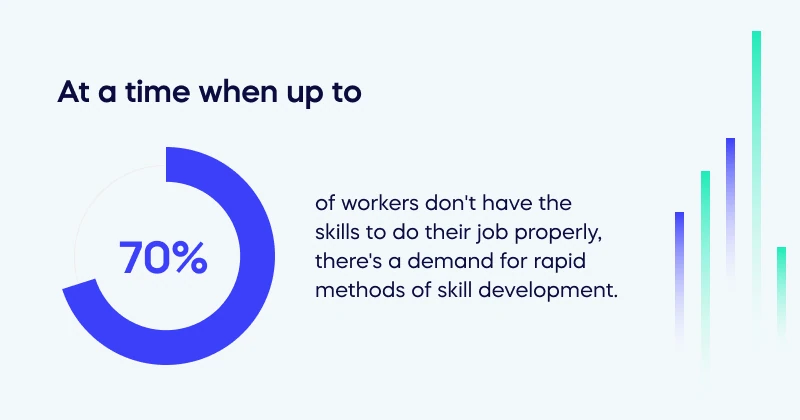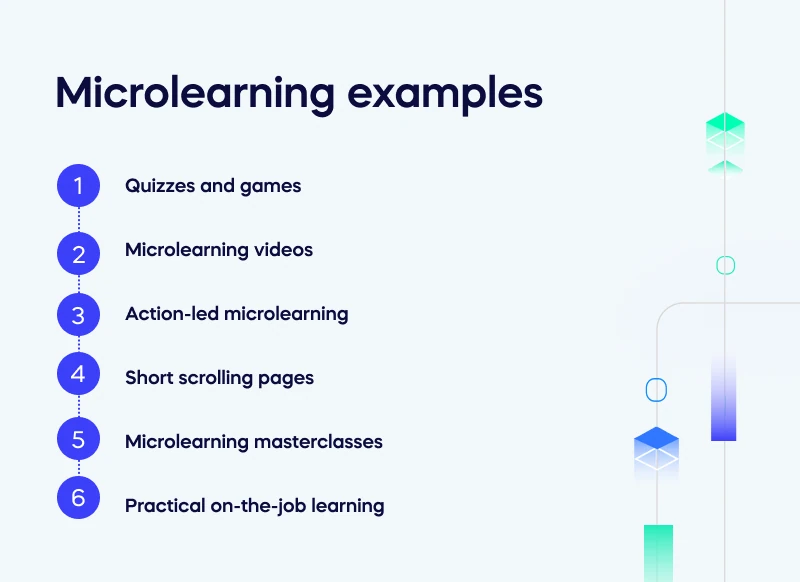What is Microlearning?
Microlearning delivers concise and focused bursts of information or learning content to learners. Often, those bursts are delivered through digital platforms or mobile devices.

Table of contents
A good microlearning intervention will be short, accessible, and immediately applicable. It helps learners to acquire specific skills or knowledge in small, easily digestible portions. Microlearning modules often contain short videos, quizzes, interactive exercises, or bite-sized text-based content.
Microlearning has become an important element of every corporate training strategy. Why? Because microlearning means that employees can meet a small learning objective in just a few minutes and get on with their work.
You may like:
- 4 Microlearning Examples from Fortune 500 Companies
- 12 Surprising Microlearning Benefits Every Organization Should Know
- The Future of Work: Revolutionizing Corporate Training
At a time when up to 70% of workers don’t have the skills to do their job properly, there’s a demand for rapid methods of skill development. Below we provide an overview of microlearning. We’ll start by defining the idea. Then, we’ll introduce some key examples and key benefits.

Why we need microlearning in 2023
In the workplace of 2023, microlearning is more important than ever. It helps to deliver relevant training to employees on a busy schedule. Whether you like it or not, getting up to speed with the microlearning experience is essential.
The world is becoming increasingly digital, and people are bombarded with information all day. This can make it difficult to focus and learn new things. Microlearning helps to overcome this challenge by breaking down complex topics into small, manageable chunks. This makes it easier for learners to focus and retain the information.
Microlearning can be used to supplement traditional training methods or to provide on-demand training. But in a digital work environment, on-demand microlearning interventions can provide a uniquely useful approach to training which is seamlessly integrated into software applications. For example, you see microlearning in action whenever you see contextual help systems, walk-through guides, and in-app guidance.
Training content in these places means employees can improve their skills “on the job” and when they need it. But, more importantly, this training helps them work without interruption.
How has microlearning changed over the years?
People have been calling microlearning “new” for many years.
When Theo Hug called it a “new pedagogical challenge” in the title to the 2005 paper Microlearning – it was! In 2023, this new teaching innovation has been adopted in countless ways, including being merged into applications, integrations, and more.
Some of the major changes that have taken place since the concept of “microlearning” was formally coined include:
- Microlearning in the workplace. Microlearning still applies in every learning environment – but it has gained significant traction in corporate training and workplace learning. Its flexibility and accessibility make it ideal for just-in-time training, performance support, and continuous learning in a fast-paced work environment. Organizations have embraced microlearning to deliver targeted, job-specific training modules and support employees’ ongoing professional development.
- An emphasis on technology. The widespread adoption of smartphones, tablets, and other mobile devices has transformed how microlearning is delivered. Learners can now access microlearning modules anytime, anywhere, and on various platforms, including apps, web-based platforms, and social media.
- Microlearning ecosystems. Microlearning has moved beyond standalone modules and has evolved into a more integrated ecosystem. Organizations and learning platforms now offer comprehensive microlearning libraries or repositories, allowing learners to access a wide range of interconnected microlearning resources.
Technology and microlearning
In practice, microlearning does not always need technology. You can implement microlearning episodes in “traditional” classroom teaching. But microlearning became a current idea when Web 2.0 started coming into its own. This is no coincidence: there is a vital link between microlearning and digital technology, and many microlearning interventions rely on mobile learning.
Microlearning is valuable for learning about digital products and services for several reasons. Microlearning’s quick and targeted interventions allow learners to acquire specific skills or knowledge related to new features, functionalities, or updates. With on-demand access to relevant information exactly when users need it, learners can apply their learning immediately, enhancing their ability to use the product or service effectively.
And at heart, digital products and services often rely on interactive interfaces and user experiences. Microlearning leverages similar interactive elements, such as videos, simulations, or gamified content, to engage learners in an immersive and hands-on learning experience.
Digital Adoption Platforms like WalkMe are one of the simplest (and most effective ways) of delivering microlearning for technological purposes.
Microlearning examples
Most people will have already experienced microlearning examples in their day-to-day life. If you’ve ever watched a how-to video, listened to a short podcast, or typed a question into a “help” bar – you have experienced a micro-learning session.
The reality is that microlearning can take on many different forms. Here are some more examples that you might be familiar with:
Quizzes and games. These are great ways to test learners’ knowledge and keep them engaged. They can introduce new concepts, reinforce existing knowledge, or assess learning outcomes.
Microlearning videos. These are short, interactive videos that can be used to explain complex topics in a simple way. Quizzes or other activities often accompany them to help learners retain the information.
Action-led microlearning. This type of microlearning focuses on providing learners with the skills they need to perform a specific task. It is often delivered through checklists, job aids, or simulations.
Short scrolling pages. These pages are designed to be read quickly and easily on a mobile device. They often update learners on new products or services or explain company policy changes.
Microlearning masterclasses. These are longer, more in-depth microlearning modules that cover a specific topic in detail. They are often used to train employees on new software or procedures.
Practical on-the-job learning. This type of microlearning occurs in the workplace and is often delivered by a mentor or supervisor. It is a great way to learn new skills and techniques by doing.
For more illustrations from the business world, check out our article, 4 Microlearning Examples from Fortune 500 Companies.

The major benefits of microlearning
We’ve already talked about some of the benefits: it’s available on-demand, it’s personalized, and it’s highly actionable. Why else would you choose to use microlearning for your product or service?
- Scalability and flexibility: Microlearning can be easily scaled and updated to accommodate evolving digital products and services.
- Flexibility: Microlearning allows learners to access and engage with learning content at their convenience and pace. Today’s employees appreciate this: research from SHRM shows that workers want to go at their own pace regarding training.
- Time efficiency: Microlearning delivers information in small, easily digestible chunks, saving time and reducing cognitive overload.
- It improved knowledge retention: Microlearning’s focused and repetitive nature promotes better retention and recall of information.
- Cost-effective: Microlearning reduces costs associated with traditional training methods by minimizing the need for extensive resources or lengthy development cycles.
- Scalability: Microlearning can be easily scaled and updated to accommodate changing organizational needs or evolving content needs.
If you want to know more, check out 12 Surprising Microlearning Benefits Every Organization Should Know.
Microlearning: What’s next?
Microlearning is more than just a regular learning and development trend. It’s one of the most important ways of navigating the digital learning curve. Based on how things are today, microlearning will be here to stay for the foreseeable future.
And indeed, as AI becomes more embedded in the digital employee experience, we will likely see new possibilities for micro-learning: with incredible levels of automation, personalization, and relevancy.